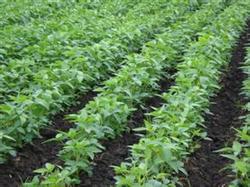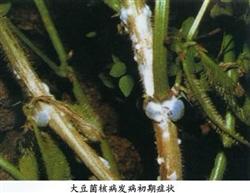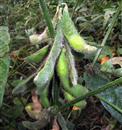Control measures of soybean diseases

Soybean Sclerotinia sclerotiorum mainly infects stems, and most of them begin to occur in late July. At the initial stage of infection, there were brown disease spots on the stems, and then there were white cotton-like mycelia and white particles on the disease spots, and then turned black particles (sclerotia). In the longitudinal section of the stem of the diseased plant, the black cylindrical mouse fecal sclerotia could be seen, and the diseased plant was grayish white after death. Chemical control: spray with 1000 times of 50% sulfamethoxazole wettable powder, or 1000 times of 50% Sclerotinol, or 50% methyl topiramate. Soybean gray spot, also known as spot disease, generally began to occur in the first and middle of June, and entered the peak period in mid-July. The disease of pods began from the tender pod stage, the grain filling stage was the peak stage, and the disease was serious from July to August with high temperature and heavy rain. It mainly harms the leaves. When the disease is serious, almost all the leaves are covered with disease spots, causing the leaves to fall off prematurely. After the damage, the yield can be reduced by 20% and 30%, and the quality of soybeans will be reduced. Chemical control: in addition to sowing with 70% dimethazone wettable powder or 50% thiram wettable powder according to 0.3% of the seed amount, but also in the soybean flower and pod stage, 40% carbendazim glue 100 grams per mu, 30 kg of water spray control.
- Prev

Occurrence and control of Sclerotinia sclerotiorum in soybean
Sclerotinia sclerotiorum is a common disease on soybean crops, which mainly causes stem rot, pale lesions, hollow stems and black sclerotia, which is easy to break. In the past two years, soybean Sclerotinia sclerotiorum has a tendency to increase year by year. Causes and characteristics: 1. The number of sclerotia in the field Sclerotinia sclerotiorum is a fungus.
- Next

Soybean disease control: downy mildew
[distribution and damage] it occurs in all soybean producing areas all over the country, especially in Northeast and North China where the temperature is cold. The disease is caused by fungal infection of Peronosporamanschurica (Naum.) Jyd.etGaum in Northeast China. Generally, the output is reduced by 6%, the price of beans is reduced by 15%, and the damage rate of beans is about 10%. Except for the great harm.
Related
- The first cup of black tea in spring, the flavor and history of tea gardens in Kenya, Africa
- The computer can not only choose potatoes, but also grow tea rice. AI will grow winter oolong tea champion.
- It is not only the inflated tea bitten by insects, but also engraved with the four seasons tea in Beipu.
- The Oriental Beauty Tea Festival in Zhuxian County takes the stage at the weekend to experience the plus-size feast of oil tea.
- & quot; Oriental Beauty Tea & Exploration of Emei in Hsinchu, the hometown of quot;
- The new variety of strawberry "Tainong 1" dessert is the first choice with mellow aroma. Crimson gorgeous
- History of Tea in Taiwan: from Wild Inner Mountain to Export Tea Garden
- Two types of Taiwan Oriental Beauty Black Tea won the British three-Star Award for Childhood Tea Xiang Zhang Jiaqi changed from pilot to champion tea maker.
- Banana species and varieties: the planting history of Taiwan Xianren banana and dwarf banana is long, is banana disease resistant?
- Coffee planting Technology: Qianjie Coffee from Seedling to harvesting

